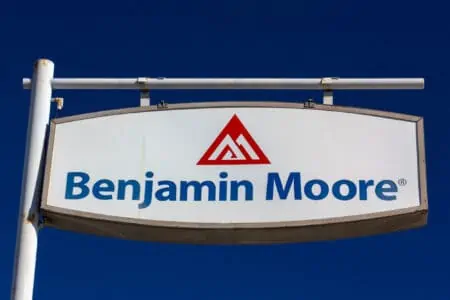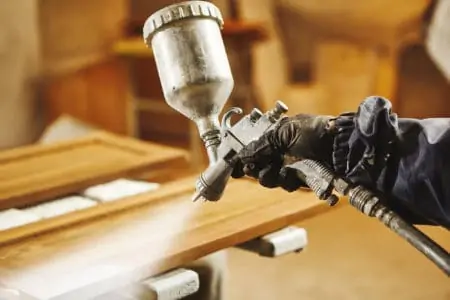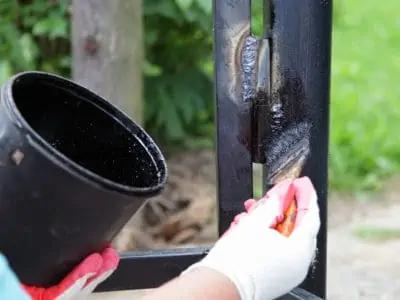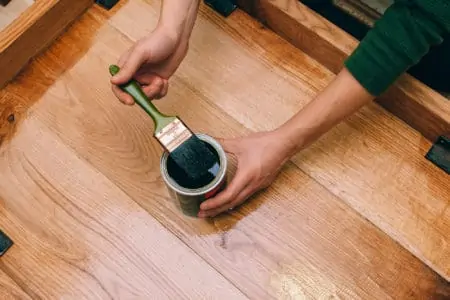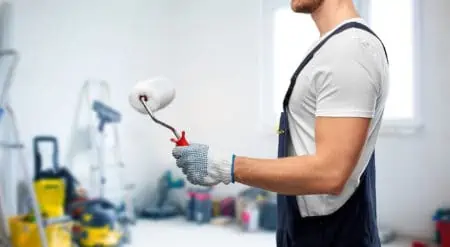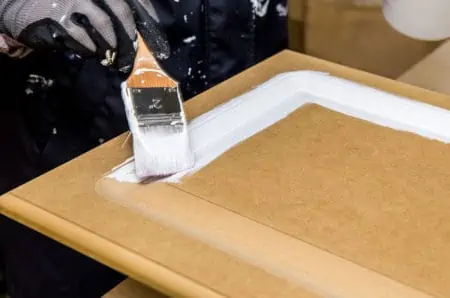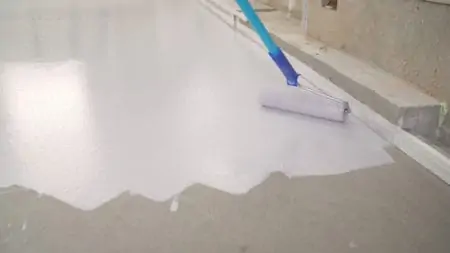Have you ever wondered why some paints cost $20 per gallon while others are close to $100? Not all paint is equal, and we’re not talking about varieties here.
Some manufacturers actually make high-quality paint, and Benjamin Moore is one of them. How much does Benjamin Moore’s paint cost in 2024? Is it worth the price? We’ll give you the info on Benjamin Moore paint prices; you decide for yourself.
Key Takeaways
- Benjamin Moore paint costs around $75 per gallon for an eggshell finish, and prices vary based on finish and type of paint (interior or exterior).
- High-quality ingredients, better pigments, and quality resins contribute to the higher cost of Benjamin Moore paint compared to other brands.
- Factors affecting the cost of Benjamin Moore paint include type of finish, eco-friendliness, and extra features such as mildew resistance and weatherproof properties.
- Benjamin Moore paint is often considered worth the price due to its durability, color variety, and low-VOC options.
- How Much is Benjamin Moore Paint?
- Why is Benjamin Moore Paint So Expensive?
- Factors Affecting Benjamin Moore Paint Cost
- Cost of Benjamin Moore Paint Products
- How Much Does It Cost to Paint a Room with Benjamin Moore Paint?
- How to Save Costs On Benjamin Moore Paint
- Benjamin Moore vs. Behr vs. Sherwin Williams Cost
- Are Benjamin Moore Paints Worth It?
- Tips For Painting with Benjamin Moore Paint
- FAQs
How Much is Benjamin Moore Paint?
One of the great things about Benjamin Moore’s paint prices is that there are loads of options available with varying costs. The different features of each line of paint will determine the end cost.
Price by Finishes
Paint grades (also known as paint finishes) will influence the price. For instance, flat paint is usually cheaper than semi-gloss. This is also reflected in the price of Benjamin Moore paint. Let’s look at an example.
Consider the Regal Select interior paint. It costs $75 per gallon with an eggshell or semi-gloss finish and $70 for the flat finish. These can stretch to $100-$150 per 5-gallon bucket.
Type
The pricing for 1 gallon of Benjamin Moore paint also depends on whether it’s for interior or exterior use. The ben line, which offers both varieties of paint, is a clear example. A gallon of ben interior paint is around $47, while exterior paint costs around $53.
Why is Benjamin Moore Paint So Expensive?
Benjamin Moore paint prices seem very expensive when you compare them to your average $20 Amazon-bought no-name paint brand. That makes many people wonder if it’s really worth the price. Why does this paint brand cost more than many other brands out there?
No Streaks
Paints that are more expensive (like those from Benjamin Moore) can last longer without fading, cracking, or chipping.
Paints of a higher quality contain thickening ingredients that allow them to roll on more slowly and provide an even coating regardless of whether they are applied with a roller or a brush.
This results in a more consistent surface and calls for fewer coats to be applied to reach the desired coverage.
Quality Resins
Resins are used to assist the pigment bind together, creating gloss, and providing overall stain coverage. Paints with a higher price tag, such as Benjamin Moore, include polymers of higher quality, making them suitable for a wider range of finishes.
Paints with a satin or eggshell finish, typically used on interior walls, effectively hide stains and smudges. Paints with a semi-gloss or gloss finish appear lustrous and are typically used for trim and molding.
Better Pigments
Cheaply-priced paints typically have lower-grade pigments. In addition, high-quality paint has smaller pigment particles, which result in greater coverage.
This gives a deeper, more intense color and is more faithful to the color on the swatch after the first coat of paint has been applied.
Factors Affecting Benjamin Moore Paint Cost
How much is a gallon of Benjamin Moore paint? There is no universally-available answer. As always, several factors influence the price of paint.
Type of Finish
- Flat Finish: It’s perfect for uneven walls as it can hide imperfections very well. It’s less reflective than other finish options and offers great coverage. Because uses for flat paint are so limited, it tends to be the cheaper of the finishes.
- Matte Finish: The lack of brightness that a matte finish provides makes it an excellent choice for concealing surface flaws. It has a good lifespan. This is a middle-of-the-road point for cost.
- Eggshell Finish: It’s great for high-traffic rooms because of its low maintenance and simple cleaning requirements. It’s one of the most common finishes and tends to cost a little more.
- Satin Finish: Has a velvety luster, offers rooms a rich look, and is easy to clean. Satin isn’t that commonly used, and the price point is often a bit higher than eggshell.
- Semi-Gloss Finish: Has a reflective surface, is easy to clean, and works in high-traffic areas. Reserved for doors and trims, it’s also about the same price as eggshell, but you don’t need as much of it.
Eco-Friendly Paints
Benjamin Moore has certain paint lines with low VOCs (volatile organic compounds). These include Eco Specs or Regal Select. Because they have low to no emissions, they are also more expensive than other paint options.
The brand’s Natura line of paints, in particular, was recognized as setting the standard for ecologically responsible products and was validated as being safe for people who suffer from asthma and allergies.
Later on, it was replaced by Eco Spec, which successfully obtained the Green Seal Certification.
Benjamin Moore focuses on the production of “greener” choices. They don’t emit any unpleasant fumes or emissions in response to the increased emphasis placed on environmentally friendly paint products.
As a direct consequence of these products’ benefits, their prices are significantly greater.
Extra Features
The price of paint can be affected by several extra attributes, such as its resistance to mildew, weatherproof properties, and endurance.
Investing in paint resistant to mildew will be more expensive if you plan to paint rooms that are prone to moisture (bathrooms in particular).
Also, if you want to paint outside structures like sheds, you need paint that is both long-lasting and resistant to the elements. Due to these new qualities, the cost of the paint per gallon will go up, but it will work better and last longer.
Cost of Benjamin Moore Paint Products
So, how much is Benjamin Moore paint? We now know it depends on the line, finish, and whether it’s interior or exterior paint.
Interior Paints
Benjamin Moore sells paint for your home’s interior, with their most popular lines being:
- Aura Interior Paint: $80 per gallon.
- ADVANCE Interior Paint: $50 per gallon.
- Ben Interior Paint: $47 per gallon.
- Muresco Ceiling Paint: $42 per gallon.
- Regal Select: $59 per gallon.
Exterior Paints
If you want to purchase exterior paint from Benjamin Moore, here are some good options:
- Aura Exterior Paint: $80 per gallon.
- Regal Select: $56 per gallon.
- Ben Exterior Paint: $53 per gallon.
How Much Does It Cost to Paint a Room with Benjamin Moore Paint?
Before beginning any painting project, you must calculate the amount of paint required for your walls. In addition, you need to investigate the procurement of many other necessities for the project (like paint brushes or rollers).
One gallon of paint from Benjamin Moore may cover anywhere from 300 to 400 square feet. You can find this information on their website.
Because the average room size in the United States ranges from 132 to 144 square feet, one gallon of paint can cover approximately two rooms with two coats.
The actual cost to paint a room also depends on what type of Benjamin Moore paint you choose. For instance, if you opt for the high-end Aura paint line, it will cost you roughly around $170 to paint a full room.
If you go with one of their economic lines of paint, it might cost you around $150 to paint a full room.
How to Save Costs On Benjamin Moore Paint
Without a shadow of a doubt, Benjamin Moore is regarded as one of the most prestigious brands of paint currently available in the market. And its expense is justifiable due to the product’s performance, features, and lifespan.
But that doesn’t mean it’s impossible to save money even when you purchase quality paint like the one Benjamin Moore manufactures. Here are some tricks for cutting down costs.
Buy in Bulk
You can purchase paint buckets ranging from one quart to five gallons, with the latter option coming at a more affordable price. It is almost certain that you will require more than one gallon if you plan to rebuild and repaint the house.
Therefore, the best strategy is to buy the paint in large quantities to take advantage of price reductions and bring the price of a gallon down.
Buy Returned Paint
This is actually a trick that not a lot of people know about. Imagine that someone pays for a custom Benjamin Moore paint color and then decides to return it. Where does that paint go?
If you’re not too picky with your paint color, you can buy it and use it yourself. It’s still the same Benjamin Moore quality paint. It’s just a color that someone else didn’t want anymore.
Scout Local Stores
When you shop in local stores, you are likely to come across discounts or get really good offers on Benjamin Moore paint. In addition, they may sometimes keep dented cans in the back of the store for customers to choose from.
You can still paint surfaces with these products so long as the paint on the inside is in good condition. A further benefit of purchasing things in physical stores is that you will not be required to pay for the price of delivery.
Apply a Single Coat
When you reduce the number of coats you apply, it may look as though you are sacrificing the coverage and color vitality of the paint, but in reality, this is not the case.
Priming a surface properly reduces the number of coats that need to be applied. Although Benjamin Moore paints are advertised as “self-priming,” it doesn’t hurt to use a primer beforehand.
This results in an increase in coverage that highlights the color of the paint and improves the paint’s ability to adhere to the wall surface. As a result, you will be able to reduce the amount of paint you need.
Benjamin Moore vs. Behr vs. Sherwin Williams Cost
While there are a lot of paint brands on the market, Benjamin Moore is regarded to have two main competitors: Sherwin-Williams and Behr.
Benjamin Moore vs. Sherwin-Williams
When comparing these two major competitors, prices aren’t all that different. Benjamin Moore’s paint usually ranges between $40 to $90 per gallon. Sherwin-Williams paint has a larger price range, starting at $40 and going up to $120.
Benjamin Moore has more paint color options (over 3,500) than Sherwin-Williams (around 1,700). So, if it’s a color variety you’re after, Benjamin Moore is the way to go.
Benjamin Moore paint is usually available in more locations in terms of availability. Still, many of them only have limited purchasing options (for instance, you’ll likely find stores that only sell the ben paint range). Sherwin-Williams has private-owned stores which are opened on weekends as well.
Some extra facts that could help you decide between these two:
- They both claim one coat of paint is enough. Contractors always suggest painting two coats, regardless of how good the coverage is.
- They both have self-leveling paint, which is best for DIYers (like Sherwin-Williams Emerald Urethane or Benjamin Moore Aura).
- Benjamin Moore’s satin paints are easier to touch up.
- Paint samples from Sherwin-Williams are more expensive than those from Benjamin Moore.
Benjamin Moore vs. Behr
Now let’s take a look at what Behr has to offer compared to what we already know we can get from Benjamin Moore:
- Behr paint is only available at The Home Depot.
- As for color options, Behr has around 1,000 choices for its customers.
- Behr has cheaper paint. You pay around $130 per five-gallon paint bucket.
- Benjamin Moore has better performing interior paint than Behr.
Are Benjamin Moore Paints Worth It?
By now, everyone has heard about Benjamin Moore. Many people regard it as the best paint brand globally, but others are still skeptical about what they offer. Some of the advantages of buying Benjamin Moore paint include:
- They offer excellent value for the money, even if they are more expensive than other brands. Not having to repaint the walls next year is worth it.
- The paint they offer is thicker and more consistent. That translates into better coverage and a fuller color appearance.
- If you’re unsure what one of their colors would look like on your walls, you can always buy a sample first and try it out.
- Their commitment to selling their products with smaller local stores instead of greedily choosing large stores and supply chains is admirable.
- They have a lot of self-priming paints that don’t require applying a coat of primer before painting.
- Their color range is impressive.
- Some of their products have zero VOCs.
Benjamin Moore products don’t come with a lot of disadvantages, but there are a few that we would like to point out:
- Unlike other brands, Benjamin Moore’s paint has limited availability. You can’t buy it on Amazon.
- Because of its low color-matching potential, you can’t substitute it. Finding a cheap and fast replacement won’t work if you run out of paint.
- Benjamin Moore’s paints are thicker and more consistent. That translates into excellent coverage but makes it more difficult to get the paint out of your painting tools.
Is Benjamin Moore’s paint worth it? If you prioritize color and durability over a lower cost, it is. Even so, you might not always need to buy such expensive paint. You can substitute Benjamin Moore paint with cheaper alternatives if you:
- Want to paint the whole house, not just patch up some areas.
- Have to paint something inconspicuous, like a cabinet in the tool shed.
- Want to paint something that isn’t subjected to a lot of wear-and-tear.
Tips For Painting with Benjamin Moore Paint
Benjamin Moore has teamed up with expert contractors and always likes to inform buyers of the best tips for a proper paint job. Here are some of those tips:
- If you really like a Benjamin Moore paint color, invest in a sampler first. You can test the paint out and see if the varying conditions in your home truly make this the right paint choice.
- Clean the surface that you want to paint thoroughly before actually painting it.
- If you do not have the time to apply primer and wait for it to cure, consider buying a self-priming Benjamin Moore paint.
- Don’t use too much paint at once because you can end up with streaks, drips, or unwanted textures.
- Don’t skimp on the quality of the painting tools, especially rollers and paint brushes.
- Not using enough paint can also lead to blotches, streaks, or uneven paint jobs. Don’t stretch your paint.
- Store whatever Benjamin Moore paint is left properly. That way, you can still use it for future projects.
